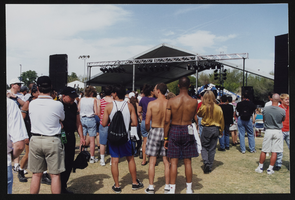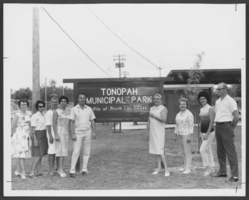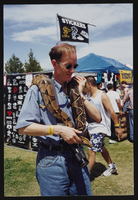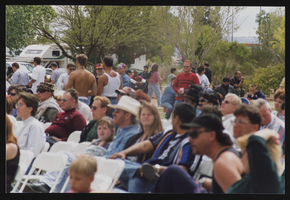Search the Special Collections and Archives Portal
Search Results
Katherine L. Rankin oral history interview
Identifier
Abstract
Oral history interview with Katherine L. Rankin conducted by Claytee D. White on June 16, 2014 for the Boyer Early Las Vegas Oral History Project. In the interview, Rankin discusses her childhood, her move to Las Vegas, Nevada, and her career as a librarian. Rankin talks about how she began her library career on the Gila River Reservation in Arizona before accepting a position as an audio and visual materials cataloger at University of Nevada, Las Vegas (UNLV) in the 1970s. Rankin later describes her work with the American Library Association, getting tenure at UNLV, and her role as a map cataloger in UNLV Special Collections and Archives.
Archival Collection

Crowd watching performaces at Gay Pride, image 004: photographic print
Date
Archival Collection
Description
Gay Pride 1999 at Sunset Park; Photographer: Dennis McBride. (5-8-99)
Image
Organizations: gay-straight student alliances: Teen Gay-Straight Alliance, 2019
Level of Description
Archival Collection
Collection Name: Dennis McBride Collection on LGBTQ Las Vegas, Nevada
Box/Folder: Box 33
Archival Component

Photograph of North Las Vegas Women's Club, North Las Vegas, July 22, 1965
Date
Archival Collection
Description
Image
Gay Academic Union and Lesbian Gay Academic Union newsletters, 1983-1985
Level of Description
Archival Collection
Collection Name: Terry Wilsey Papers on the Las Vegas, Nevada LGBT Community
Box/Folder: Box 01 (Restrictions apply)
Archival Component

Dennis McBride holding a boa constrictor at Gay Pride: photographic print
Date
Archival Collection
Description
Gay Pride 1999 at Sunset Park. Dennis McBride with boa.
Image

Crowd watching performaces at Gay Pride, image 001: photographic print
Date
Archival Collection
Description
Gay Pride 1998 at Sunset Park. Photographer: Dennis McBride. (4-25-98)
Image
Vegas PBS Interviews for the African Americans in Las Vegas: a Collaborative Oral History Project
Identifier
Abstract
Oral history interviews with Ruby Amie Pilot, Eva G. Simmons, Melvin Sanders, Jarmilla McMillan-Arnold, Hannah Brown, Sonny Thomas, and Claytee White conducted by Vegas PBS on April 01, 2013, April 02, 2013, April 12, 2013, and November 19, 2013 for the African Americans in Las Vegas: a Collaborative Oral History Project. In these interviews, the participants discuss their early lives and moving to Las Vegas, Nevada. Pilot talks about segregation on the Las Vegas Strip, integration, and the importance of church activities in the African American community. Simmons describes her career as a teacher, the schools on the Westside, and businesses on Jackson Street. Thomas describes the funeral industry and his role as a funeral director. McMillan-Arnold talks about segregated Las Vegas, African American entertainers, and the issue of homelessness on the Westside. Brown remembers growing up on the Westside, segregated schools, and her role as President of the National Coalition of 100 Black Women – Las Vegas chapter. Lastly, Sanders discusses his childhood in Las Vegas, being the son of a preacher, and the redevelopment of the Westside.
Archival Collection
